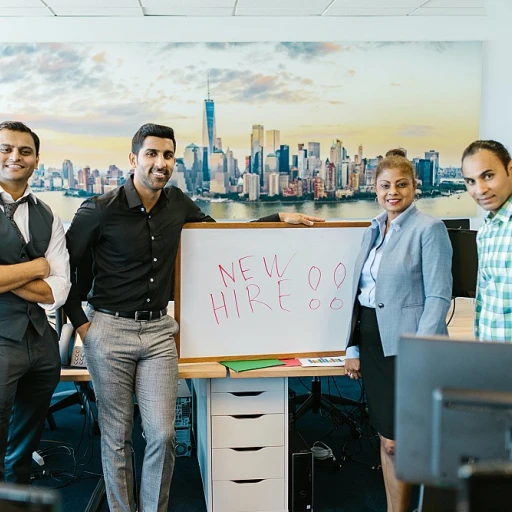
Understanding Process Improvement Consulting
Grasping the Essence of Process Improvement Consulting
In today's fast-paced business environment, organizations are constantly seeking ways to enhance efficiency and reduce costs. Process improvement consulting has emerged as a vital service that helps businesses streamline their operations and achieve better performance. At its core, this type of consulting focuses on analyzing current processes and identifying areas where improvements can be made. By leveraging methodologies like lean sigma and process mapping, consulting firms provide tailored solutions that align with an organization's specific needs.
Process improvement consulting is not just about fixing what's broken; it's about fostering a culture of continuous improvement. This involves a comprehensive evaluation of business processes, from supply chain management to shared services, to ensure that every aspect of the operation is optimized. Consulting services often include the development of standard operating procedures and process engineering to enhance the overall management system.
One of the key benefits of improvement consulting is the potential for significant cost savings. By identifying inefficiencies and implementing best practices, organizations can reduce waste and improve their bottom line. Moreover, these improvements can lead to a better customer experience, as streamlined processes often result in faster service delivery and higher quality outcomes.
For businesses looking to enhance their hiring processes, process improvement consulting can be particularly beneficial. By working with a consulting firm, organizations can identify bottlenecks and develop strategies to streamline recruitment efforts. This not only saves time but also ensures that the best candidates are selected efficiently.
To explore the benefits of process improvement consulting further, consider the insights offered by Freestar HR software, which provides innovative solutions for hiring tech professionals.
Identifying Bottlenecks in Hiring Processes
Pinpointing Obstacles in Recruitment Plans
In any organization, identifying bottlenecks in hiring processes can be a daunting task. Yet, addressing these obstacles is crucial for improving operational efficiency and reducing costs. Recruitment performance can be severely impacted by inefficiencies in current processes, leading to extended time-to-hire and higher organizational expenses.
Effective process improvement requires comprehensive process mapping. This method helps visualize and assess the step-by-step nature of the hiring process, highlighting areas for improvement. Additionally, involving an external consulting firm can provide an objective viewpoint and expert guidance in optimizing these processes.
Consider engaging your group and team in continuous improvement discussions to gather insights from varied perspectives. Collective input often reveals inefficiencies that may have been overlooked, aiding in the enhancement of operating procedures.
By adopting lean sigma principles, organizations can streamline recruitment operations, ensuring a higher level of staff performance and improved management system results. Moreover, adopting best practices from shared services and other sectors can yield cost savings and elevate the overall customer experience for both candidates and hiring managers alike.
To delve deeper into the potential of streamlining recruitment processes, explore our article on unlocking the potential of programmatic job advertising in tech hiring.
Strategies for Streamlining Recruitment
Efficient Recruitment Strategies
Enhancing recruitment efficiency is a multi-faceted approach that can yield significant results for any organization. The process improvement consulting field plays a crucial role here, offering strategies to streamline the recruitment process, improve team collaboration, and ultimately reduce costs and time spent on hiring. One effective strategy is the implementation of lean principles in the recruitment process, which focuses on eliminating waste and optimizing every step involved. By adopting a lean approach, organizations can enhance their operational performance, reduce redundancy, and expedite hiring timelines. Process mapping is another essential tool in the streamlining journey. By meticulously mapping out each step of the recruitment process, businesses can identify inefficiencies and areas for improvement more clearly. This visualization helps teams to work collaboratively, ensuring everyone understands their role, responsibilities, and deadlines, contributing to improved organizational efficiency and a better customer experience for candidates. Moreover, integrating continuous improvement with recruitment practices allows for the constant evolution of hiring procedures. This iterative approach not only helps in fine-tuning current processes but also encourages innovation and improvement solutions that adapt to changing market dynamics and workforce demands. Transitioning to shared services models in recruitment could also offer substantial benefits. By centralizing recruitment functions, businesses can achieve standardized operating procedures, streamlined communication, and centralized data management systems. Finally, engaging a consulting firm that specializes in process engineering can bring a wealth of expertise and best practices from a broad spectrum of industries. These consulting services can help organizations develop tailored improvement solutions, implement robust management systems, and ensure compliance with standard operating procedures. These strategic approaches, when implemented effectively, can significantly enhance a business’s recruitment process. They allow organizations to focus less on inefficiencies and more on attracting the right talent swiftly and effectively. However, keep in mind that 'factors that can disqualify you from a level 2 background check' may still impact some candidates during the hiring process.Leveraging Technology for Better Outcomes
Harnessing Digital Tools for Recruitment Optimization
Leveraging technology in hiring processes can significantly improve outcomes, streamlining operations, enhancing efficiency, and reducing cost. One of the key benefits of integrating technology into recruitment lies in its capacity to automate repetitive tasks. Recruitment software solutions such as applicant tracking systems (ATS) help organizations manage applications efficiently, tracking candidates through each stage of the hiring process without manual intervention. Incorporating tech-driven solutions also entails adopting tools that facilitate process mapping and ongoing process improvement. For instance, process improvement consulting firms often advocate the use of lean sigma principles to systematically eliminate inefficiencies within hiring processes. This not only improves the speed of recruitment but also enhances the overall customer experience for applicants. Another critical aspect is utilizing data analytics to improve decision-making. By analyzing metrics and applicant data, recruitment teams can better understand where bottlenecks occur, enabling them to address these issues proactively. These insights can drive continuous improvement, ensuring that recruitment strategies remain agile and responsive to the organization's evolving needs. Shared services platforms also present an opportunity for organizations to enhance their hiring processes by integrating standard operating procedures and best practices across different divisions and locations. Through a robust management system, recruiting teams from various parts of the organization can collaborate effectively, ensuring consistency and alignment with the organizational goals. Moreover, digital platforms facilitate collaboration among group and team members, ensuring that everyone involved in the hiring process can communicate, share feedback, and make informed decisions quickly. This not only enhances performance but also fosters a sense of shared responsibility and accountability. Additionally, technology can play a pivotal role in cost savings by optimizing the supply chain of recruitment services. Automation in operational tasks reduces the need for excessive manual labor, thereby lowering the operational cost and improving the overall performance of the recruiting services. Ultimately, the strategic use of technology in hiring processes not only enhances operational efficiency but also contributes to the organization's overall business process improvements by aligning recruitment strategies with business objectives. With the help of innovative tools, organizations can refine their hiring processes, achieving not just cost savings but also qualitative improvements in workforce selection and management.Measuring Success in Process Improvement
Evaluating the Impact of Improvement Consulting on Recruitment
The journey of enhancing the hiring process through process improvement consulting emphasizes the critical role of measuring outcomes. Determining the success of your initiatives requires a comprehensive approach that examines various facets of your organization's hiring operations.- Performance Metrics: Central to evaluating process improvement is the establishment of performance metrics. These metrics should be aligned with your business goals, considering key indicators like time-to-fill, cost-per-hire, and candidate quality. By focusing on these factors, organizations can gauge the effectiveness of process changes.
- Cost Savings: Another critical indicator of success is the realization of cost savings. By streamlining recruitment processes, companies can significantly reduce the resources spent on each hire. This can be assessed by comparing pre- and post-implementation budgets, ensuring that financial efficiency has been achieved.
- Improved Organizational Operations: Process improvement is not only about immediate gains but also about fostering long-term benefits. By improving the hiring processes, an organization enhances its operational capabilities and promotes a seamless workflow across departments, enabling better management of increased workloads and fostering continuous improvement.
- Employee and Customer Experience: The benefits of process enhancement should reflect in improved employee and customer experiences. Streamlined procedures contribute to a more engaging and less cumbersome process for both candidates and hiring managers, ultimately leading to a better reputation and stronger employer branding.
- Feedback Loops: Regularly gathering feedback from the internal recruitment team and external candidates helps identify areas for further improvement. Establishing feedback mechanisms is vital for adapting strategies and services to meet evolving organizational needs and expectations.
Case Studies: Success Stories in Hiring Tech
Real-World Examples of Process Improvement in Hiring
In the realm of hiring tech, several organizations have successfully implemented process improvement strategies to enhance their recruitment operations. These case studies highlight the transformative power of consulting services and the tangible benefits of adopting best practices in process improvement.
Case Study 1: Streamlining Recruitment with Lean Sigma
A leading consulting firm collaborated with a multinational corporation to refine its hiring processes using Lean Sigma methodologies. The focus was on reducing time-to-hire and improving candidate experience. By mapping out the current processes and identifying bottlenecks, the team was able to implement a series of improvements that reduced recruitment cycle times by 30%. This not only led to significant cost savings but also enhanced the overall performance of the HR team.
Case Study 2: Enhancing Shared Services for Better Outcomes
An organization in the supply chain sector sought to improve its shared services operations. Through process engineering and the adoption of standard operating procedures, the company was able to streamline its hiring processes. The consulting group provided tailored improvement solutions that aligned with the company's business objectives. As a result, the organization experienced a 25% increase in efficiency and a marked improvement in customer experience.
Case Study 3: Leveraging Technology for Continuous Improvement
A tech startup faced challenges with its recruitment management system, which was impacting its ability to scale operations. By engaging with a process improvement consulting firm, the startup was able to integrate advanced technology solutions that automated repetitive tasks and improved data management. This shift not only optimized the recruitment process but also allowed the HR team to focus on strategic initiatives, ultimately leading to better organizational performance.
These success stories underscore the importance of process improvement in hiring. By leveraging consulting services and adopting a continuous improvement mindset, organizations can significantly enhance their recruitment operations, leading to improved business outcomes.












